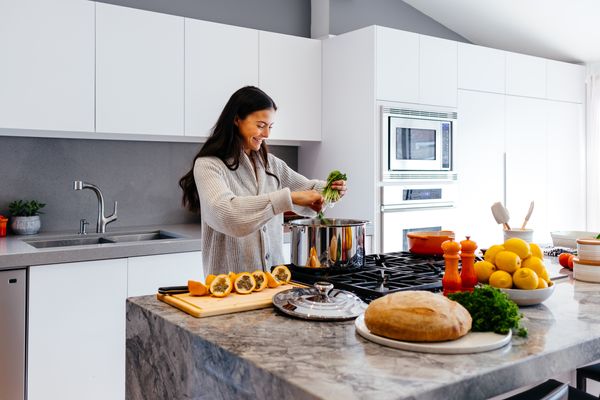
At a Glance:
Understanding Your Kitchen Needs
How to Measure for a Cooktop vs Range
Cooktops: Features, Pros, and Cons
Ranges: Features, Pros, and Cons
Why Trust Appliance Solutions?
Choosing the right cooking appliance for your kitchen is a decision that can transform your culinary adventures, turning them into delightful experiences or, at the very least, making them less of a hassle. The heart of this decision lies in the pivotal question: what does your kitchen need—a cooktop vs range? Both have their unique allure and specific benefits. This guide will walk you through the essential factors to consider, from understanding your kitchen's layout and your cooking habits, to the technical aspects of measuring for a perfect fit. By the time you're finished reading, you'll have the clarity needed to choose the ideal appliance that complements your lifestyle.
Browse Our Selection of Cooking Appliances
If you're in the market for a replacement cooking appliance or planning a kitchen remodel, make sure to explore Appliance Solutions and our wide selection of brands and styles.
Cooking AppliancesUnderstanding Your Kitchen Needs
Assessing Kitchen Space and Layout
Let's face it—space is the ultimate frontier in kitchen design. The dimensions and layout of your kitchen play a crucial role in determining the best appliance fit. Start by examining your kitchen's existing layout, taking note of cabinetry, countertops, and any awkward corners or spaces that might present an installation challenge. A cooktop might offer more flexibility for smaller kitchens, allowing the installation of cabinetry underneath. Conversely, a range could serve as a focal point in larger kitchens, providing both cooking and baking capabilities in one unit. Keep in mind, too, the flow of your kitchen; ensuring that your new appliance fits seamlessly into the cooking triangle—your fridge, sink, and stove area—can enhance efficiency and comfort.
Lifestyle and Cooking Habits
Your cooking habits are as unique as your fingerprint. Some folks whip up gourmet meals daily, while others prefer quick and simple dining solutions. The frequency and style of your cooking should guide your appliance choice. If you're someone who enjoys baking bread as much as sizzling stir-fries, a range with a spacious oven might be your best bet. On the other hand, if your culinary escapades are more stovetop-centric, a cooktop paired with a separate wall oven could offer more flexibility. Consider also the number of mouths you're feeding. Larger families or those who entertain often might find the expansive surface and oven capacity of a range more suitable.
Learn more: 6 Cooktop with Rangehood Pairings You’ll Love
How to Measure for a Cooktop vs Range
Measuring for a Cooktop
Precision is key when measuring for a cooktop. Start by measuring the length and width of the countertop space available. Remember to leave a little breathing room for ventilation, as cooktops require good airflow to function efficiently. Also, note the location of your electrical or gas connections—these will dictate where your cooktop can comfortably reside without the need for costly rewiring or extensions. Don't forget about the height of your cabinetry; there's nothing worse than finding out your new cooktop doesn't allow your pot handles to turn freely.
Measuring for a Range
Measuring for a range involves a few more steps, but it's fairly straightforward. First, measure the width of the space where the range will sit—standard widths are typically 30, 36, or 48 inches. Next, measure the height from the floor to the bottom of your kitchen cabinets to ensure there's enough clearance. Be sure to account for door swing and nearby cabinets or islands to avoid any cooking collisions. Finally, look behind the range space to assess the location of utility connections; an electric range will need a 220-volt outlet, while gas ranges require a gas line.
Learn more: Fry High This Summer: Beat the Heat with Air Fryer Magic
Types of Cooktops and Ranges
Cooktops
The best cooktop types come in several types, each with their perks and quirks. Gas cooktops are favored for their quick heat control, making them a chef's favorite for precision cooking. Electric cooktops, with their sleek surfaces, are often easier to clean and can offer consistent heat distribution. Then there are induction cooktops, the tech-savvy option that uses electromagnetic fields to heat pots and pans directly, offering both speed and energy efficiency. While induction cooktops tend to be pricier, their safety features, like cooler-to-touch surfaces, can be a compelling choice for families.
Ranges
Ranges, the all-in-one cooking machines, come in three main styles: freestanding, slide-in, and drop-in. Freestanding ranges are the most versatile, capable of fitting into any kitchen design. Slide-in ranges offer a built-in look with controls at the front, eliminating the need for a backsplash. Drop-in ranges, on the other hand, require custom cabinetry and are often seen in high-end kitchens. Each style offers its own aesthetic and functional benefits. The choice between these styles often comes down to how you want your kitchen to look and feel.
Cooktops: Features, Pros, and Cons
Features of Cooktops
Cooktops are packed with features designed to enhance your cooking experience. From different burner types, whether you're sautéing or simmering, to advanced control options that allow precise temperature settings, cooktops cater to diverse cooking styles. Safety features, such as auto shut-off and child locks, offer peace of mind, particularly in homes with young children.
Pros of Cooktops
The main advantage of cooktops is their flexibility in kitchen design. They allow for separate wall ovens, which can be placed at a more convenient height. Cooktops also tend to be easier to clean, with fewer nooks and crannies for grease to hide. This setup is perfect for those who prefer a clean, streamlined look in their kitchen.
Cons of Cooktops
However, cooktops are not without their downsides. The most significant is the need for a separate oven, which can be a deal-breaker for those with limited kitchen space. Additionally, cooktops typically offer less cooking space than ranges, which might be a concern for those who enjoy hosting large gatherings or cooking expansive meals.
Ranges: Features, Pros, and Cons
Features of Ranges
Ranges are the workhorses of the kitchen world, offering an array of features designed to enhance both cooking and baking. Many models boast large oven capacities, a variety of burner types, and additional functionalities such as convection cooking and self-cleaning settings. These features make ranges a one-stop solution for all cooking needs.
Pros of Ranges
One of the biggest advantages of ranges is their all-in-one functionality. With both a stovetop and an oven in a single unit, ranges save space and often cost less than purchasing a separate cooktop and oven. They also typically offer a larger cooking capacity, making them ideal for families or those who entertain often.
Cons of Ranges
Despite their many advantages, ranges come with some drawbacks. Their size can be imposing in smaller kitchens, and the installation can be more challenging, particularly if retrofitting an older kitchen. Additionally, ranges often require more energy to operate, which could impact utility bills.
Learn more: Spice Up Your Kitchen Game with a THOR Cooktop
Featured Products
Maytag 30" Fingerprint Resistant Stainless Steel Freestanding Electric Range
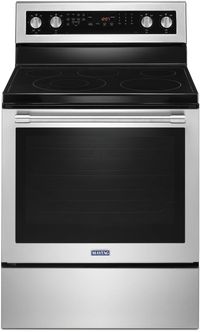
Maytag 30in Freestanding Electric Range
Bringing modern aesthetics and functionality together, this Maytag electric range is designed to meet all cooking needs. With its fingerprint-resistant finish, it looks pristine even with heavy use. The spacious oven and versatile burners make meal preparation a breeze.
KitchenAid 36" Commercial-Style Freestanding Gas Range
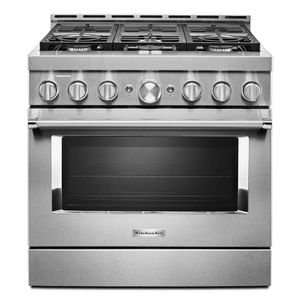
KitchenAid 36in Freestanding Gas Range
For those looking to elevate their cooking experience, this KitchenAid gas range combines professional-grade features with the convenience of home cooking. Its robust design and powerful burners ensure even the most ambitious meals are cooked to perfection.
KitchenAid 30" Stainless Steel Slide-In Induction Range
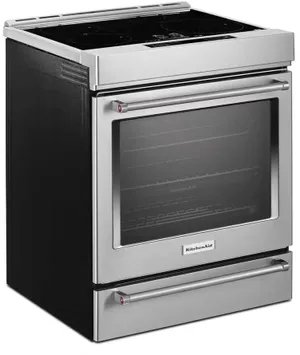
KitchenAid 30in Slide In Induction Range
A blend of technology and style, this KitchenAid induction range offers quick and efficient cooking with precise temperature control. Its sleek design fits seamlessly into modern kitchens, making it a top choice for tech-savvy cooks.
Samsung 36" Black Electric Cooktop

Samsung 36in Black Electric Cooktop
Samsung’s electric cooktop strikes a balance between form and function. Its smooth surface and intuitive controls simplify cooking, while the black finish adds a contemporary touch to any kitchen.
KitchenAid 36" Stainless Steel Gas Cooktop
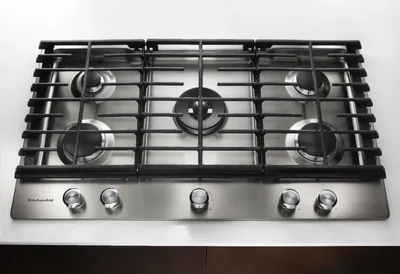
For those who love the control of gas cooking, this KitchenAid gas cooktop delivers with precision and style. Its durable construction and easy-to-clean surface make it a practical addition to any kitchen.
Whirlpool 30" Black Induction Cooktop
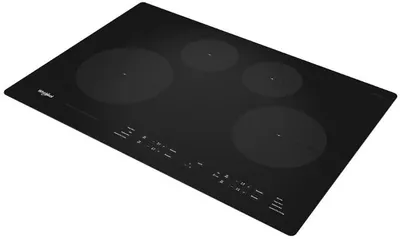
Whirlpool 30in Black Induction Cooktop
Efficiency meets elegance with this Whirlpool induction cooktop. Offering rapid heating and energy savings, it’s perfect for those who want fast, reliable cooking in a sleek package.
Conclusion
Deciding between a cooktop vs range involves weighing various factors, from kitchen layout and cooking habits to the specific features you value most. Both options offer unique advantages that can transform your cooking space into a culinary haven. As you weigh the pros and cons, remember that the right choice is the one that aligns best with your lifestyle and kitchen design. We invite you to explore the featured products for more detailed specifications and purchasing options at Appliance Solutions Tulsa. Let’s get cooking!
Cooktop vs Range FAQs
What is the difference between a cooktop and a range?
A cooktop is a standalone cooking surface that nestles into your countertop, while a range combines both the cooking surface and an oven in one unit, perfect for those who love all-in-one convenience.
What does cooktop mean?
A cooktop is a flat cooking surface with burners or heating elements, ideal for those wanting a sleek kitchen look without the bulk of an oven underneath.
What do chefs prefer, a cooktop or range?
Chefs often prefer cooktops for their flexibility and ability to pair with wall ovens at comfortable heights, but some appreciate ranges for their compact, all-in-one functionality.
Which is more energy-efficient, a cooktop or a range?
Induction cooktops are typically the most energy-efficient, directly heating pots and pans, while ranges vary based on model and fuel type.
How do installation and cost compare between a cooktop and a range?
Cooktops can be more expensive to install due to the need for separate ovens and potential countertop modifications, whereas ranges usually have a lower initial installation cost due to their all-in-one design.
Why Trust Appliance Solutions of Tulsa?
Appliance Solutions of Tulsa is proud to have served greater Tulsa with the best home and outdoor appliances since 1994. From the beginning, our mantra has always been “Crazy Good Deals and Legendary Service.” We believe in delivering top-notch customer service at every stage of the buying journey. From initial product research to service after sale, we’ll be with you. Shop refrigerators, ranges, cooktops, ovens, dishwashers, washers, dryers, and more. You’ll find deals and service that other stores simply can’t match. Shop with us today!
Shop Cooktops & Ranges at Appliance Solutions
At Appliance Solutions of Tulsa, our focus is on the customer. Our professional team is dedicated to helping you find Cooktops or Ranges — whether you call us at 918-712-0304, email us, or use our online texting feature. Visit our Tulsa appliance showroom today to experience what sets Appliance Solutions apart.